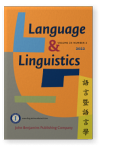Vol. 23:2 (2022) ► pp.313–328
Tangut uvularization and the devil in the Chinese details
I critique traditional simplex approaches to Tangut Grade by primary reference to Xun Gong’s new suggestion that Grade I/II syllables were contrastively uvularized. Such proposals are rooted in the categories of philological Middle Chinese (MC), but the Grades are at the same time incommensurate with MC in reflecting the effects of apicalization, labiodentalization, and other changes affecting vocalism across northern late medieval Chinese languages (NLMC). Attention to these details suggests that Tangut Grade concerned vowel quality per se, not simplex diagnostic segments or features. Gong’s correspondence between Tangut Grade I/II K- and Rgyalrong Q- also has parallels in NLMC and will require a narrower solution within proposed Qiangic.
Article outline
- 1.Introduction
- 2.A view from northern late medieval Chinese languages
- 3.Discussion
- 3.1“Rank” and “Division”
- 3.2Tangut /K-/ as Grade I/II [Q-] vs. Grade III [K-]
- 3.3Old Chinese Type A “pharyngealized” onsets
- 4.Conclusions
- Acknowledgements
- Notes
- Abbreviations
-
References
For any use beyond this license, please contact the publisher at [email protected].
